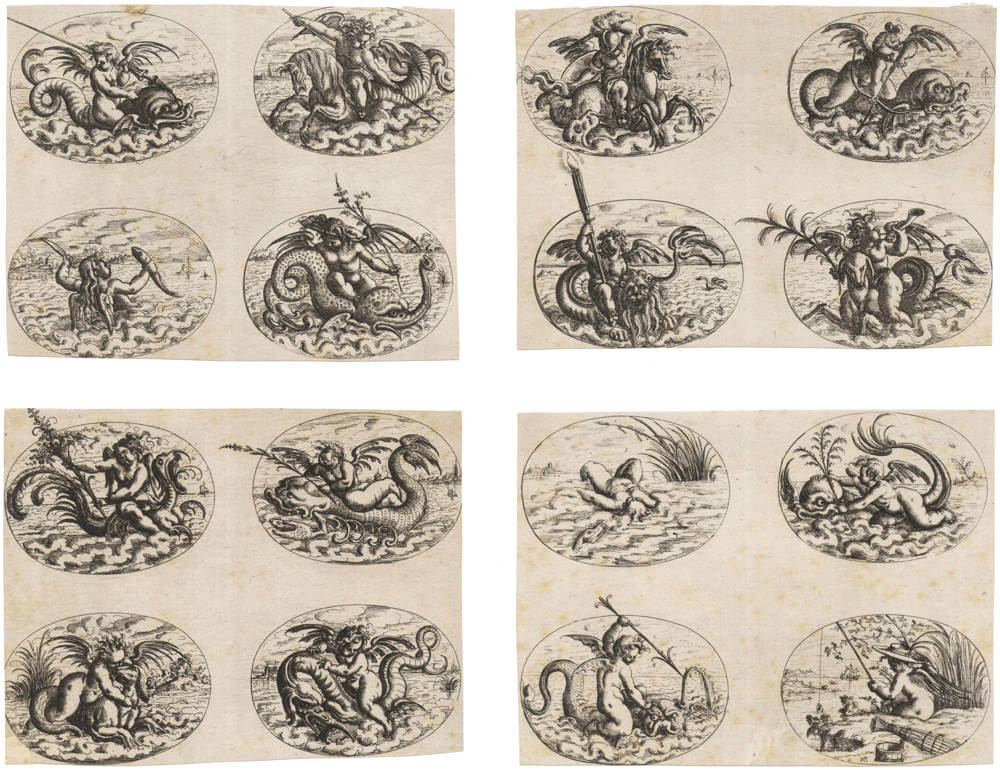Leen Helmink Antique Maps & Atlases
www.helmink.com
Jamnitzer
[ Sixteen etchings ]
Certificate of Authentication and Description
This is to certify that the item illustrated and described below is a genuine antique
map, print or book that was first produced and published in 1610, today 415 years ago.
December 15, 2025
Cartographer(s)
Jamnitzer
First Published
Nuremberg, 1610
This edition
1610 first and only edition
Size
12.0 x 16.5 cms
Technique
Copper etchings
Stock number
19497
Condition
excellent


Description
Four sheets with legendary and iconic engravings/etchings, each sheet with four oval grotesques, depicting a total of sixteen scenes with mermaids, mermen, putti, sea horses and sea monsters. All drawn and copper-engraved/etched by Christoph Jamnitzer.
From Neuw grotteßken Buch inventirt gradirt und verlegt durch Christoph Jamnitzer, Nuremberg, 1610, one of the masterpieces of Baroque art.
Very rare.
The majority of copies of the book are preserved in public institutions. In 1979, Warncke counted seven complete copies in the libraries of the British Museum, Bamberg, Nuremberg, Stockholm, Vienna, Coburg and Wolfenbüttel. In Paris, the copy in the BNF and the two in the École nationale supérieure des beaux-arts are incomplete by one or more plates. Of the copies cited by Warncke, only that of the Herzog August Bibliothek in Wolfenbüttel is preserved in its original binding. Of the other three copies, perhaps still in private hands, the first two - the Versbow copy (Christie's Cat., April 9, 2013, no. 50) and the one offered by the bookseller Halwas - are incomplete by one leaf; a third, whose plates have been re-embossed, is incomplete by one printed leaf (dedication or privilege?) and in modern binding.
(Christie's)
Literature
Andresen, IV, pp. 244-264 ; Katalog Berlin, 32 ; Warncke, « Christoph Jamnitzers Neuw Grottesken Buch – ein Unikat in Wolfenbüttel », in Wolfenbüttel Beitrage, 3, 1978, pp. 65-87 ; Warncke, Die ornementale Groteske in Deutschland, 1500-1650 : Text- und Bilddokumentation, Berlin, Spiess, 1979, nos 926-988 ; Jamnitzer, Nouveau livre de grottesques. Introduction de Juliette Jestaz, ENSBA, 2012, passim.
Christoph Jamnitzer (1573-1610)
Grandson of the Nuremberg silversmith Wenzel Jamnitzer (1508-1585), known as "the German Cellini", and a renowned silversmith himself, Christoph Jamnitzer (1563-1618) is best known for his sumptuous Baroque goldsmiths. However, his name is also associated with the collection of ornamental motifs he published in Nuremberg in 1610. Intended for silversmiths and their apprentices, the New Book of Grotesques offers a collection of cartouches, medallions, candelabras and coiled leathers, more or less complicated with grotesque masks... Clumsy putti and hybrid monsters, each more improbable than the last, indulge in unbridled facetiousness, to the point where fantasy seems to take precedence over any didactic concern. The artist has thrown together a jubilant imagination, a phantasmagoria of rare invention, from which parody, irony and eroticism are not excluded. The result is a surrealist world before its time, where Bosch and Brueghel are joined by Grandville, Lewis Carroll and Max Ernst.